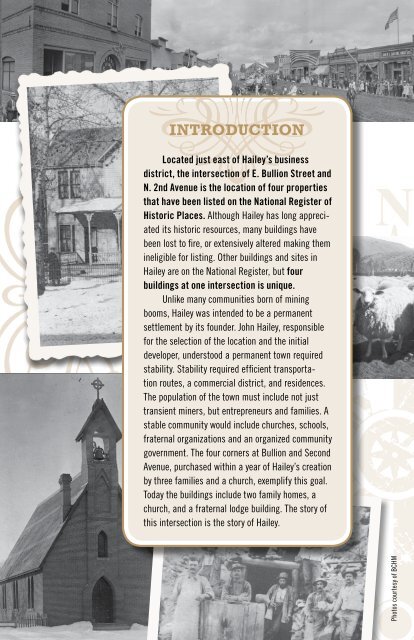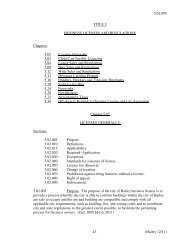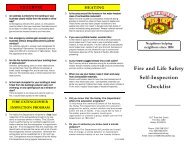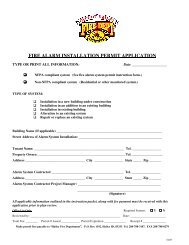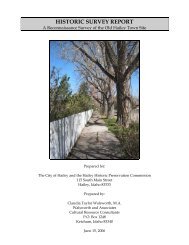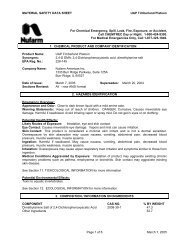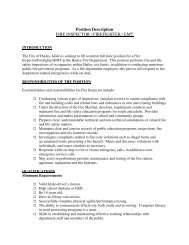Create successful ePaper yourself
Turn your PDF publications into a flip-book with our unique Google optimized e-Paper software.
Introduction<br />
Located just east <strong>of</strong> <strong>Hailey</strong>’s business<br />
district, the intersection <strong>of</strong> E. Bullion Street and<br />
N. 2nd Avenue is the location <strong>of</strong> four properties<br />
that have been listed on the National Register <strong>of</strong><br />
Historic Places. Although <strong>Hailey</strong> has long appreciated<br />
its historic resources, many buildings have<br />
been lost to fire, or extensively altered making them<br />
ineligible for listing. Other buildings and sites in<br />
<strong>Hailey</strong> are on the National Register, but four<br />
buildings at one intersection is unique.<br />
Unlike many communities born <strong>of</strong> mining<br />
booms, <strong>Hailey</strong> was intended to be a permanent<br />
settlement by its founder. John <strong>Hailey</strong>, responsible<br />
for the selection <strong>of</strong> the location and the initial<br />
developer, understood a permanent town required<br />
stability. Stability required efficient transportation<br />
routes, a commercial district, and residences.<br />
The population <strong>of</strong> the town must include not just<br />
transient miners, but entrepreneurs and families. A<br />
stable community would include churches, schools,<br />
fraternal organizations and an organized community<br />
government. The four corners at Bullion and Second<br />
Avenue, purchased within a year <strong>of</strong> <strong>Hailey</strong>’s creation<br />
by three families and a church, exemplify this goal.<br />
Today the buildings include two family homes, a<br />
church, and a fraternal lodge building. The story <strong>of</strong><br />
this intersection is the story <strong>of</strong> <strong>Hailey</strong>.<br />
Photos courtesy <strong>of</strong> BCHM<br />
A Brief History <strong>of</strong> <strong>Hailey</strong><br />
P<br />
rospectors and miners were busy in the Wood River area as early as 1864,<br />
but conflicts with native residents, transportation problems, and lack <strong>of</strong> mining<br />
technology slowed development <strong>of</strong> mines in the area until the late 1870s. Successful<br />
entrepreneur John <strong>Hailey</strong> purchased land between Bellevue and Ketchum in December<br />
1880. Before the year ended he founded a new town, <strong>Hailey</strong>. In 1881, political ambition<br />
drew <strong>Hailey</strong> from the Wood River area to Boise and he sold his land to the Idaho-Oregon<br />
Land Improvement Company. The new owners included railroad promoter Robert Strahorn<br />
who used his considerable skills and connections to boost the town.<br />
<strong>Hailey</strong> prospered in the 1880s. In 1883 the Oregon Short Line arrived. Soon the town<br />
had the first telephone, 1883, and electric light service, 1889, in the territory. In these<br />
same years, disastrous fires struck the downtown business district, yet the town rebuilt.<br />
<strong>Hailey</strong> enjoyed a few more years <strong>of</strong> prosperity until the Wood River mines faltered and<br />
failed about the time <strong>of</strong> the nationwide Panic <strong>of</strong> 1893. Although some mines operated<br />
in fits and starts after this, the days <strong>of</strong> the boom were over and <strong>Hailey</strong>, along with other<br />
Wood River communities, had to find other ways to maintain its population. Livestock,<br />
particularly sheep, became an important part <strong>of</strong> the economic base. The U.S. Forest<br />
Service began to administer grazing and timber harvest on Forest Service lands and in<br />
the mid-1930s the agency built a large administrative site in <strong>Hailey</strong>. As smaller towns<br />
diminished in size and services, <strong>Hailey</strong>’s role as a supply center strengthened.<br />
The scenic beauty <strong>of</strong> the Wood River Valley attracted many visitors even in the 19th<br />
century. The development <strong>of</strong> better roads in the 1920s and<br />
1930s increased tourist traffic. Although the creation <strong>of</strong> Sun<br />
Valley resort in 1936 had a more direct impact on Ketchum,<br />
<strong>Hailey</strong> felt the increase in numbers <strong>of</strong> visitors and potential<br />
residents—both those who came to enjoy the benefits <strong>of</strong><br />
leisure activities and the work force required to support<br />
them. When tourism combined with the startup <strong>of</strong> a mining<br />
operation, as happened in <strong>Hailey</strong> when the Triumph mine<br />
reopened in the 1930s, the result was a small boom in<br />
population.<br />
• 1 •<br />
Photo by Mallory; Courtesy <strong>Hailey</strong> Public Library<br />
John <strong>Hailey</strong>


